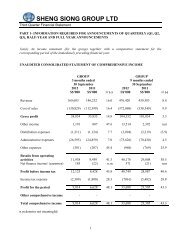FY 2011 Annual Report - Sheng Siong
FY 2011 Annual Report - Sheng Siong
FY 2011 Annual Report - Sheng Siong
Create successful ePaper yourself
Turn your PDF publications into a flip-book with our unique Google optimized e-Paper software.
56 <strong>Sheng</strong> <strong>Siong</strong> <strong>Annual</strong> <strong>Report</strong> <strong>2011</strong><br />
Notes to the Financial Statements<br />
4 Significant accounting policies (Continued)<br />
4.11 Finance income and finance costs<br />
Finance income is recognised as it accrues in profit or loss, using the effective interest method.<br />
Finance costs and similar charges are expensed in profit or loss in the period in which they are incurred,<br />
except to the extent that they are capitalised as being directly attributable to the acquisition, construction or<br />
production of an asset which necessarily takes a substantial period of time to be prepared for its intended use<br />
or sale. The interest component of finance lease payments is recognised in profit or loss using the effective<br />
interest rate method.<br />
4.12 Income tax expense<br />
Income tax expense comprises current and deferred tax. Current tax and deferred tax are recognised in profit<br />
or loss except to the extent that it relates to items recognised directly in equity or in other comprehensive<br />
income.<br />
Current tax is the expected tax payable or receivable on the taxable income or loss for the year, using tax<br />
rates enacted or substantively enacted at the reporting date, and any adjustment to tax payable in respect of<br />
previous years.<br />
Deferred tax is recognised in respect of temporary differences between the carrying amounts of assets and<br />
liabilities for financial reporting purposes and the amounts used for taxation purposes. Deferred tax is not<br />
recognised for:<br />
• temporary differences on the initial recognition of assets or liabilities in a transaction that is not a business<br />
combination and that affects neither accounting nor taxable profit or loss; and<br />
• temporary differences related to investments in subsidiaries to the extent that it is probable that they<br />
will not reverse in the foreseeable future.<br />
Deferred tax is measured at the tax rates that are expected to be applied to the temporary differences when<br />
they reverse, based on the laws that have been enacted or substantively enacted by the reporting date.<br />
Deferred tax assets and liabilities are offset if there is a legally enforceable right to offset current tax liabilities<br />
and assets, and they relate to income taxes levied by the same tax authority on the same taxable entity, or on<br />
different tax entities, but they intend to settle current tax liabilities and assets on a net basis or their tax assets<br />
and liabilities will be realised simultaneously.<br />
A deferred tax asset is recognised for unused tax losses, tax credits and deductible temporary differences,<br />
to the extent that it is probable that future taxable profits will be available against which they can be utilised.<br />
Deferred tax assets are reviewed at each reporting date and are reduced to the extent that it is no longer<br />
probable that the related tax benefit will be realised.



